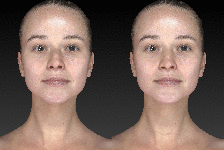A chin augmentation procedure can improve the appearance of a patient’s chin and enhance facial contour. Dr. John R. Griffin performs the chin augmentation procedure on Bay Area patients who wish to improve the shape of the face and bring the chin into proportion with other facial features.
Vectra 3D Imaging for Chin Augmentation
|
Vectra 3D imaging technology helps patients visualize their potential individual outcomes. During the ching augmentation consultation, Dr. Griffin will take a 3D image of the patient. Once the image is displayed on his computer screen, Dr. Griffin will simulate a realistic before and after result by adjusting the contour of the patients chin on the image. |
Chin Augmentation Candidates
Patients who are unhappy with the size or shape of the chin, yet have normal jaw function, are the best candidates for a chin augmentation procedure. A chin augmentation is well suited to patients with a recessed chin
To be considered good candidates for this plastic surgery procedure, patients should be in good general health, have normally functioning immune systems, and be non-smokers.
Chin Augmentation Techniques
Most chin augmentation procedures are performed with the under the chin incision, as this approach may be associated with a lower incidence of infection.
- Under the chin: In this technique, the implant is placed between the lower jawbone and chin tissue through a small incision that is made under the chin.
- Mouth: In this approach, the incision is made inside the mouth between the lower lip and gum.
Chin Augmentation Procedure Steps
A chin augmentation procedure generally takes about an hour to complete. The procedure involves the following steps:
- A surgical pen marks the incision site
- The patient is put under anesthesia
- Antibacterial solution is applied to the chin
- The incision is made under the chin or in the mouth
- A pocket is created between the tissue and lower jaw
- The implant is inserted into the pocket, directly over the bone of the lower jaw
- The implant is positioned properly, and then the incision is closed with sutures
- Medical tape or bandages are applied
Chin Augmentation Recovery
It is best to keep the head elevated as much as possible for the first few days following surgery; this will encourage healing and reduce the amount of bruising and swelling. Normal activities may be resumed within a few days of surgery, but heavy exercise and contact sports should be avoided for the first month until the chin is fully healed.
Chin Augmentation Side Effects
The side effects of the chin augmentation procedure are relatively mild. Patients may experience an initial loss of sensation in the lower jaw and chin for the first day following surgery. This should gradually return to normal. In addition to the initial loss of sensation in the lower jaw, patients may experience discomfort, swelling, and bruising around the mouth and lower jaw. These effects should fade a week or two after surgery.
Chin Augmentation Risks
Some of the risks associated with chin augmentation surgery include:
- Sensation to the jaw may be either temporarily or permanently altered
- The implant may shift position and require revision surgery
- An infection could develop, potentially making it necessary to remove the implant.
- The patient could react poorly to anesthesia
- Jawbone, mandible resorption
- Bleeding
Chin Augmentation Results
A chin augmentation procedure can improve the appearance of the chin and the overall shape of the face. Results should start to be visible within the first week following surgery, after swelling and bruising starts to go away.
Chin Augmentation Consultations
To schedule a chin augmentation consultation with Dr. Griffin, contact his practice today.



